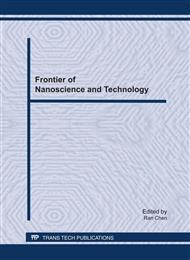[1]
Asl, M. N., & Hosseinzadeh, H., 2008. Review of pharmacological effects of Glycyrrhiza sp. and its bioactive compounds. Phytotherapy Research, 22, 709–724.
DOI: 10.1002/ptr.2362
Google Scholar
[2]
Isbrucker R.A. & Burdock G.A., 2006. Risk and safety assessment on the consumption of Licorice root (Glycyrrhiza sp. ), its extract and powder as a food ingredient, with emphasis on the pharmacology and toxicology of Gly. Regulatory Toxicology and Pharmacology, 46, 167–192.
DOI: 10.1016/j.yrtph.2006.06.002
Google Scholar
[3]
Kimura M., Moro T. & Motegi H., 2008. In vivo Gly accelerates liver regeneration and rapidly lowers serum transaminase activities in 70% partially hepatectomized rats. European Journal of Pharmacology, 579, 357–364.
DOI: 10.1016/j.ejphar.2007.10.073
Google Scholar
[4]
Kurisu S, Inoue I, Kawagoe T, Ishihara M, Shimatani Y, Nakama Y, Maruhashi T, Kagawa E, Dai K, Aokage T, Matsushita J, Ikenaga H. S. Kurisu, I. Inoue, T. Kawagoe, et al., 2008. Clinical profile of patients with symptomatic Gly-induced hypokalemia. Journal of the American Geriatrics Society, 56, 1579–1581.
DOI: 10.1111/j.1532-5415.2008.01781.x
Google Scholar
[5]
Tsuyoshi Y., Kazuki A., Tadayuki I., Tokiyoshi M., K.W., Tetsuji S., Toshitsugu S. & Hideo I., 2007. Inhibitory effect of glycyrrhizin on lipopolysaccharide and d-galactosamine-induced mouse liver injury European. Journal of Pharmacology, 576, 136-142.
DOI: 10.1016/j.ejphar.2007.08.012
Google Scholar
[6]
Ram, A., Mabalirajan, U., Das, M., Bhattacharya, I., Dinda, A. K., Gangal, S.V. & Ghosh B., 2006. Glycyrrhizin alleviates experimental allergic asthma in mice. International Immunopharmacology, 6, 1468–1477.
DOI: 10.1016/j.intimp.2006.04.020
Google Scholar
[7]
Nose M., Ito M., Kamimura K., Shimizu M. & Ogihara Y., 1994. A comparison of the antihepatotoxic activity between glycyrrhizin and glycyrrhetinic acid. Planta Medica, 60, 136–139.
DOI: 10.1055/s-2006-959435
Google Scholar
[8]
Okamoto T. & Kanda T., 1999. Glycyrrhizin protects mice from concanavalin A-induced hepatitis without affecting cytokine expression. International Journal of Molecular Medicine , 4, 149–152.
DOI: 10.3892/ijmm.4.2.149
Google Scholar
[9]
Okamoto T., 2000. The protective effect of glycyrrhizin on anti-Fas antibody-induced hepatitis in mice. European Journal of Pharmacology, 387, 229–232.
DOI: 10.1016/s0014-2999(99)00807-9
Google Scholar
[10]
Kimura, M., Inoue, H., Hirabayashi, K., Natsume, H. & Ogihara, M., 2001. Glycyrrhizin and some analogues induce growth of primary cultured adult rat hepatocytes via epidermal growth factor receptors. European Journal of Pharmacology, 431, 151–161.
DOI: 10.1016/s0014-2999(01)01424-8
Google Scholar
[11]
Fujisawa, K., Watanabe, H. & Kimata, K., 1973. Therapeutic approach to chronic active hepatitis with glycyrrhizin. Asian Medical Journal, 23, 745-756.
Google Scholar
[12]
Suzuki, H., Ohta, Y., Takino, T., Fujisawa, K. & Hirayama, C., 1983. Effects of glycyrrhizin on biological tests in patients with chronic hepatitis. A double-blind trial. Asian Medical Journal, 26, 423-438.
Google Scholar
[13]
Arase, Y., Ikeda, K., Murashima, N., Chayama, K., Tsubota, A., Koida, I., Suzuki, Y., Saitoh, S., Kobayashi, M. & Kumada, H., 1997. The long term efficacy and glycyrrhizin in chronic hepatitis C patients. Cancer, 79, 1494–1500.
DOI: 10.1002/(sici)1097-0142(19970415)79:8<1494::aid-cncr8>3.0.co;2-b
Google Scholar
[14]
Ikeda, K., Arase, Y., Kobayashi, M., Saitoh, S., Someya, T., Hosokawa, T., Senzaki, H., Akuta, N., Suzuki, Y., Suzuki, F. & Kumada, H., 2006. A long term glycyrrhizin injection therapy reduces hepatocellular carcinogenesis rate in patients with interferon-resistant active chronic hepatitis C: a cohort study of 1249 patients. Digestive Diseases and Sciences, 51, 603–609.
DOI: 10.1007/s10620-006-3177-0
Google Scholar
[15]
van Rossum, T.G.J., Vulto, A.G., Hop, W.C. & Schalm, S.W., 2001. Glycyrrhizin induced reduction of ALT in European patients with chronic hepatitis C. The American journal of gastroenterology, 96, 2432–2437.
DOI: 10.1111/j.1572-0241.2001.04049.x
Google Scholar
[16]
van Rossum, T.G.J., Vulto, A.G., Hop, W.C., Brouwer, J.T., Niesters, H.G. & Schalm, S.W., 1999. Intravenous glycyrrhizin for the treatment of chronic hepatitis C: a double-blind, randomized, placebo-controlled phase I/II trial. Journal of Gastroenterology and Hepatology. 14, 1093–1099.
DOI: 10.1046/j.1440-1746.1999.02008.x
Google Scholar
[17]
Yang X.L., Xu H.B., Wu J.Z. & Xie C.S., 2000. Application of Nano-Technology in the Research of Traditional Chinese Medicine. Journal of Huazhong University of Science and Technology, 28, 104-105.
Google Scholar
[18]
Reverchon E., De Marco I. & Torino E., 2007. Nanoparticles production by supercritical antisolvent precipitation: A general interpretation. The Journal of Supercritical Fluids, 43, 126-138.
DOI: 10.1016/j.supflu.2007.04.013
Google Scholar
[19]
Lee L.Y., Wang C.H. & Smith K.A., 2008. Supercritical antisolvent production of biodegradable micro and nanoparticles for controlled delivery of paclitaxel. Journal of Controlled Release, 125, 96-106.
DOI: 10.1016/j.jconrel.2007.10.002
Google Scholar
[20]
Chattopadhyay P. & Gupta R.B., 2001. Production of griseofulvin nanoparticles using supercritical CO2 antisolvent with enhanced mass transfer. International Journal of Pharmaceutics, 228, 19-31.
DOI: 10.1016/s0378-5173(01)00803-1
Google Scholar
[21]
Kim M.S., Jin S.J., Kim J.S., Park H.J., Song H.S., Neubert R.H.H. & Hwang S.J., 2008. Preparation, characterization and in vivo evaluation of amorphous atorvastatin calcium nanoparticles using supercritical antisolvent (SAS) process. European Journal of Pharmaceutics and Biopharmaceutics, 69, 454-465.
DOI: 10.1016/j.ejpb.2008.01.007
Google Scholar
[22]
Reverchon E., Della Porta G., Sannino D. & Ciambelli P., 1999. Supercritical antisolvent precipitation of nanoparticles of a zinc oxide precursor. Powder Technology, 102, 127-134.
DOI: 10.1016/s0032-5910(98)00207-1
Google Scholar
[23]
Park J., Park H. J., Cho W., Cha K. H., Kang Y. S., Hwang S. J., 2010. Preparation and pharmaceutical characterization of amorphous cefdinir using spray-drying and SAS-process. Pharmaceutical Nanotechnology, 396, 239–245.
DOI: 10.1016/j.ijpharm.2010.06.032
Google Scholar
[24]
Kojima H, Sakurai S, Uemura M, Takekawa T, Morimoto H, Tamagawa Y, Fukui H., 2005. Difference and similarity between non-alcoholic steatohepatitis and alcoholic liver disease. Alcoholism, Clinical and Experimental Research, 29, 259-263.
DOI: 10.1097/01.alc.0000191776.37626.30
Google Scholar


